Forum Replies Created
-
AuthorPosts
-
 Denis BuczynskiParticipant
Denis BuczynskiParticipant1) Where did this object originally form and where has it resided in the Solar System since its formation 4.6 Billion years ago?
2) Has its original orbit(within the asteroid belt?) around the Sun been constantly altered by planetary perturbations etc?
3) What was its present orbit and period around the Sun prior to impact with the Earth?
4)How has its orbit evolved to put it on an Earth crossing orbit.
5) Have there been previous near misses in the past?
Signed INTERESTED and CURIOUS of TARBATNESS Denis BuczynskiParticipant
Denis BuczynskiParticipantHello all, My main observing programme is astometry and monitoring of comets. The year is divided into 3 parts for me here in Tarbatness Highland Scotland at 59d N latitude. The fisrt is the months from Jan-May when observing is possible ina dark sky. The second is frOm mid May-mid August when no observing is possible due to all night bright twilight, Then third from mid August-December when observing is possible in a dark sky. During the second period of the year only observations of NLC are possible. Vitually no observations were made of the bright naked eye comet C/2020F3 NEOWISE in June/July due to the twlight conditions. Contrary to other parts of the UK which saw good spring and summer conditions that allowed pleasant observing, here in Highland Scotland the weather was fairly grey, overcast and cool. However I was able to observe on 106 nights when comet imaging took place and I included 87 reports of photometry of comet 29p a target for the 29P MISSION progamme run by Richard Miles for the BAA Comet Section. My two meteor cameras were operating through the year apart form the summer shutdown months and around 2000 meteors were captured on each camera and reported to NEMOTODE. The year was comparable to previous years for observing.
 Denis BuczynskiParticipant
Denis BuczynskiParticipantHi Alan, I am looking forward to the ATS meeting online. Can you please tell me your surname, you will know who you are but I cannot place you with a simple A for a surname.
Best wishes
Denis
 Denis BuczynskiParticipant
Denis BuczynskiParticipantDenis Buczynski
Denis Buczynski It is good to read about observer experiences from around the world which feature in this issue of the magazine. The historical material pays a tribute to observers of the past who made comet observations in a completely different way to the techiniques we use today. Also as free read it is well worth the effort of downloading. Denis Buczynski BAA Comet Section Denis BuczynskiParticipant
Denis BuczynskiParticipantRichard, so the answer was in your memory bank. You are one of the few people who must have listened to anything I say! I will buy you that beer next time we meet. I will have to think up a more difficult and obscure question next time and make sure I haven’t already plied you with the answer!
Denis
 Denis BuczynskiParticipant
Denis BuczynskiParticipantRichard you must have cheated by looking up the names on the internet, I had hoped that the answer would have resided in your memory! Ah well, you win. Next time I see you at a meeting I will bring your prize , a 16×20 inch mounted print of Comet Arend Roland taken by Reggie Waterfield in April 1957 (when you were still a boy) Yes you are correct. The Donohoe medal was awarded over 250 times by the ASP and there are so many famous names amongst the recipients. I have written an article for the upcoming editon of The Comet’s Tale about this and other comet medals.
 Denis BuczynskiParticipant
Denis BuczynskiParticipantThanks to all, it was the link that Dominic gave that took me back far enough in the EBULLETINS to 2007 that I wanted Denis
 Denis BuczynskiParticipant
Denis BuczynskiParticipantHi Nick(Evetts) too many Nicks around the the Comet Section, better to have a distinctive name.Your excellent image of C/2020F8 is in the BAA Comet Archive at this link:
https://britastro.org/cometobs/2020f8/2020f8_20200501_nevetts.jpg
Let us hope that the weather cooperates as the comet climbs higher into northern skies. It would be good if the comet had an outburst of dust to help visibilty, at present it is a gassy comet which means low contrast in bright skies. I am not sure about any effect of forward scattering in the comet/ earth/ sun geometry, perhaps there will be some enhancement due to that effect. I hope we don’t get lots of “I was dissapointed with this comet” comments like we have had with C/2019Y4. OK this comet has not (as yet) lived up to the show that its 1844 counterpart put on but the chance for us to watch the slow crumbling of this comet as it approaches perihelion has been fascinating and my thoughts about observing this series of events have been anything but a feeling of disapointment. Even now after the fragmentation events of April the comet is slowly brightening again. Keep watching is my advice, don’t take you eye off the ball that is C/2019Y4 ATLAS!
23 March 2020 at 12:01 pm in reply to: Unidentified moving object in field of C/2019Y4 (ATLAS) #582130 Denis BuczynskiParticipant
Denis BuczynskiParticipantHi David, the fuzz is almost certainly a ghost of the bright star at the center of the frame. I had a similar fuzz appear on a sequence of one of my comet image runs. After I had done astrometry on the fuzz and sent it to Nick James he ran the astrometry though FindOrb and the result was an ludicrous earth orbit object. So I suspect your fuzz will be the same, a ghost image of the bright star. Nice image of the comet though, please send it to me for the BAA Comet Archive. Denis
 Denis BuczynskiParticipant
Denis BuczynskiParticipantPaul how about this which is currently on the ASTROBUYSELL website:
159452 For Sale Active No Photo
Zhumell Z12, 12″ Dobsonian Refector Telescope with F5 focal ratio £150 2020-03-09 13:34:57 YORK, EnglandI have no link with the seller, I do not know what the condition is.
Denis Denis BuczynskiParticipant
Denis BuczynskiParticipantI get these intrusive trails on my meteor cameras predominantly in the morning before dawn. Here are two images close together on the morning of March 12. As astronomers we record what ever is going on in our skies, these man made events will be part of that. We were all excited to see Sputnik in 1957, it heralded a new era for mankind, this latest development in part of the same era. Let us hope that the effect of these on our images can be diminished in the future by making them less reflective, but don’t hold your breath waiting for that to happen!
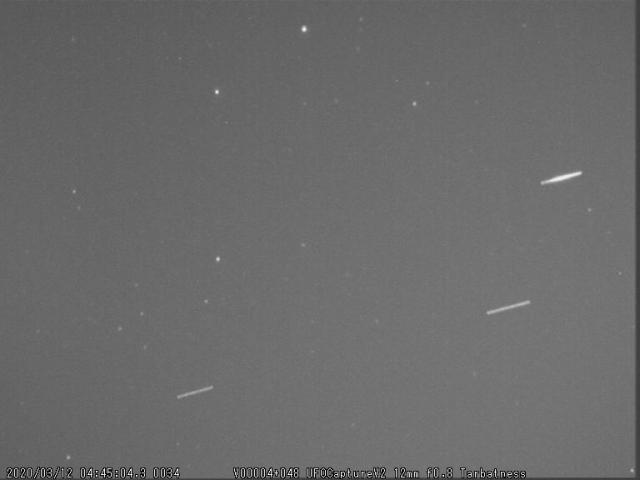
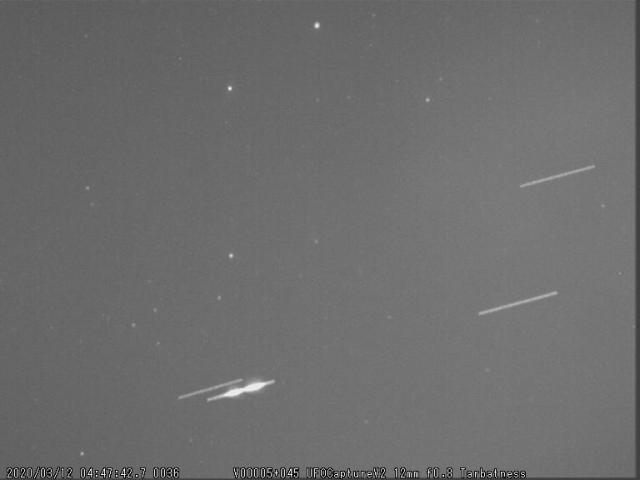
 Denis BuczynskiParticipant
Denis BuczynskiParticipantMy latest image of this spectacle is now posted in my members page and in the recent images section of this website.
Denis
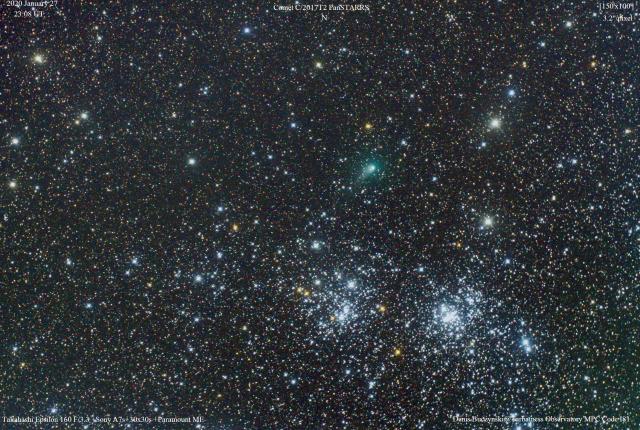 8 January 2020 at 12:17 am in reply to: BAA 2020: Highlighting Women in Astronomy From BAA President Alan Lorrain #581876
8 January 2020 at 12:17 am in reply to: BAA 2020: Highlighting Women in Astronomy From BAA President Alan Lorrain #581876 Denis BuczynskiParticipant
Denis BuczynskiParticipantIt is interesting that the LSST is to be named after Vera Rubin.Her interest in astronomy has been life long and she has always been an active observer. Here are two pictures of her as a young woman one with her homemade telscope and the other using the refractor at Vassar College. So from humble instrumental begginings to the largest telescope in the World. There is progress for you!
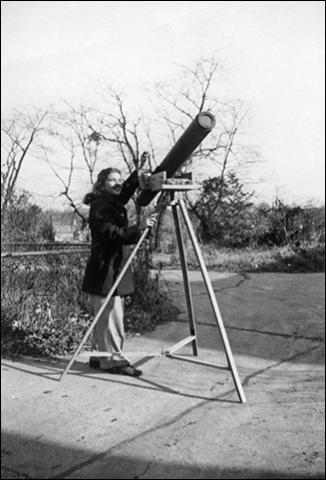
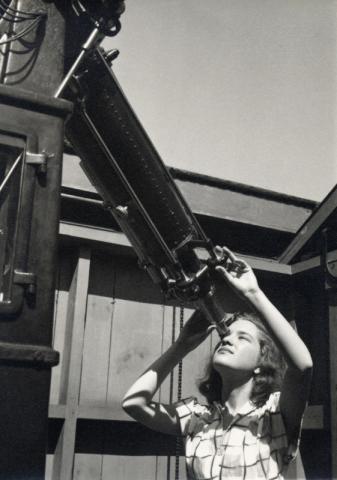
 Denis BuczynskiParticipant
Denis BuczynskiParticipantSome of my observing statistics for 2019 at Tarbatness Highland Scotland are as follows:
Comets:
Number of nights astrometric images were taken and measured 65 ( over 600 individual comet positions submitted to MPC)
Monthly nights when comet imaging was undertaken, ( nights of full or near full moon condtions did not allow comet imaging)
Jan 9, Feb7, Mar 4, Apr 7, May 2, August 6, Sept 9, Oct 8, Nov 6 Dec 8.Meteors;
Number of meteors recorded on two cameras were 3937 ( there are duplicates in these as the fields overlap)Number of nights on which meteors were recorded 214 ( this is a rough measure of when some clear sky allowed meteors to be recorded. On some nights are only there are only short periods of clear but other nights have long clear periods. The cameras are not operating in the months from mid May- mid August due to all night twilight at this lattitude 58d N.
Monthly nights on meteor cameras; Jan 24, Feb 26, March 22, April 15, May 10, August 20, Sept 24, Oct 25, Nov 20, Dec 28
Hours at the telescope, in the observing room at the computer. imaging for aurora and noctilicent clouds were not recorded.
Denis Buczynski
 Denis BuczynskiParticipant
Denis BuczynskiParticipantPaul give Henry an email at this address in France, he is looking for SBIG cameras etc.
; he says : I am still looking for exactly those parts, I am not sure how to leave a message – I would be grateful if you could pass on my interest and details. I would like to chat with Paul.
 Denis BuczynskiParticipant
Denis BuczynskiParticipantSend the query to the Antique Telescope Society at this link:
ADDRESS:
Antique Telescope Society
Walter H. Breyer, Secretary
1878 Robinson Road
Dahlonega, GA 30533E-Mail:
whbreyer@gmail.com
or to:
Bart Fried Denis BuczynskiParticipant
Denis BuczynskiParticipantHi Andrew I used a book called Moon Mars and Venus A concise guide in colourpublished by Hamlyn in 1978. It contains the Rukl map in small sections and is very easy to use at the telescope Attached is a one of the sections which I have scanned. It is available from Amazon as a used book for about £20
https://www.amazon.co.uk/Moon-Venus-Concise-Guides-Colour/dp/0600362191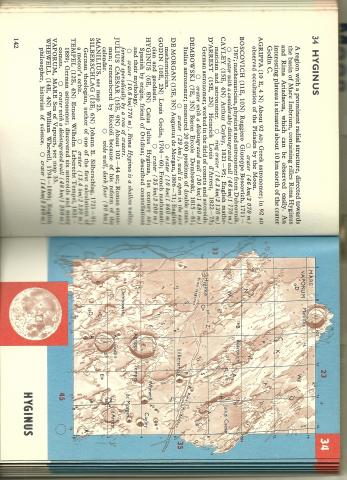
 Denis BuczynskiParticipant
Denis BuczynskiParticipantHi Nick, You showed an image of Arend-Roland taken on Oct 24 1957 by Waterfield, any chance that the trial across the comet image was Sputnick launched on Oct 4 which survived for 21 days?
Probably wishful thinking but worth the ask!
Denis
 Denis BuczynskiParticipant
Denis BuczynskiParticipantI remember the late great Harold Ridley used to measure photographs on film of objective prism captured spectra of fireball taken with his own equipment and also those of Henry Soper whose equipment was on The Isle of Man. I think some of these results will have been published in the JBAA. I may be wrong but I seem to remember that Harold was the first person(in the UK?) to record a fireball spectrum on film. He measured the films using plate measurments techiniques.
 Denis BuczynskiParticipant
Denis BuczynskiParticipantI have collected S@T from 1950 to 2012 and stopped taking it when it became so much poorer than it used to be. The highlight of my postal month used to be when S@T dropped through the letterbox. Then it became a huge disapointment as I looked at the reduced number of pages and the loss of serious observing advice by experts such asthat given in John Bortle’s Comet Digest. The relegation of the ATM telescope making pages to a single page was a big loss. The editorials seems to be concentrated on what the editorial team was doing rather than highlighting the latest developments in astronomy. Can S@T survive and become a popular magazine for amateurs and regain some of the prominence it once held. I hope so, but I am not holding my breath!
-
AuthorPosts
